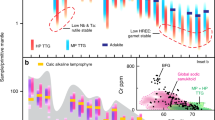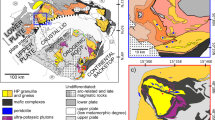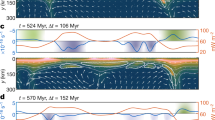Abstract
Collision tectonics and the associated transformation of continental crust to high-pressure rocks (eclogites) are generally well-understood processes, but important contradictions remain between tectonothermal models and petrological–isotopic data obtained from such rocks. Here we use 40Ar–39Ar data coupled with a thermal model to constrain the time-integrated duration of an orogenic cycle (the burial and exhumation of a particular segment of the crust) to be less than 13 Myr. We also determine the total duration of associated metamorphic events to be ∼20 kyr, and of individual heat pulses experienced by the rocks to be as short as 10 years. Such short timescales are indicative of rapid tectonic processes associated with catastrophic deformation events (earthquakes). Such events triggered transient heat advection by hot fluid along deformation (shear) zones, which cut relatively cool and dry subducted crust. In contrast to current thermal models that assume thermal equilibrium and invoke high ambient temperatures in the thickened crust, our non-steady-state cold-crust model satisfactorily explains several otherwise contradictory geological observations.
This is a preview of subscription content, access via your institution
Access options
Subscribe to this journal
Receive 51 print issues and online access
$199.00 per year
only $3.90 per issue
Buy this article
- Purchase on Springer Link
- Instant access to full article PDF
Prices may be subject to local taxes which are calculated during checkout







Similar content being viewed by others
References
Austrheim, H. & Griffin, W. L. Shear deformation and eclogite formation within granulite facies anorthosites of the Bergen Arcs, western Norway. Chem. Geol. 50, 267–281 (1985)
Koons, P. O., Rubie, D. C. & Frueh-Green, G. The effects of disequilibrium and deformation on the mineralogical evolution of quartz-diorite during metamorphism in the eclogite facies. J. Petrol. 28, 679–700 (1987)
Leech, M. L. Arrested orogenic development: eclogitization, delamination and tectonic collapse. Earth Planet. Sci. Lett. 185, 149–159 (2001)
Bjørnerud, M., Austrheim, H. & Lund, M. G. Processes leading to eclogitization (densification) of subducted and tectonically buried crust. J. Geophys. Res. 107(B10), 2252–2269 (2002)
Chopin, C. Very-high pressure metamorphism in the western Alps: implications for subduction of continental crust. Phil. Trans. R. Soc. Lond. A 321, 183–197 (1987)
Andersen, T. B., Jamtveit, B., Dewey, J. F. & Swensson, E. Subduction and eduction of continental crust: major mechanisms during continent-continent collision and orogenic extensional collapse, a model based on the south Norwegian Caledonies. Terra Nova 3, 303–310 (1991)
Dewey, J. F., Ryan, P. D. & Andersen, T. B. Orogenic uplift and collapse, crustal thickness, fabrics and metamorphic phase changes: the role of eclogites. Geol. Soc. Lond. Spec. Publ. 76, 325–343 (1993)
Hynes, A., Arkani-Hamed, J. & Greiling, R. Subduction of continental margins and the uplift of high-pressure metamorphic rocks. Earth Planet. Sci. Lett. 140, 13–25 (1996)
Bingen, B., Austrheim, H., Whitehouse, M. J. & Davis, W. J. Trace element signature and U-Pb geochronology of eclogite-facies zircon, Bergen Arcs, Caledonies of W Norway. Contrib. Mineral. Petrol. 147, 671–683 (2004)
Jamtveit, B., Bucher-Nurminen, K. & Austrheim, H. Fluid controlled eclogitization of eclogites in deep crustal shear zones, Bergen Arcs, western Norway. Contrib. Mineral. Petrol. 104, 184–193 (1990)
Boundy, T. M. & Fountain, D. M. Structural development and petrofabrics of eclogite facies shear zones, Bergen Arcs, western Norway: implications for deep crustal deformation processes. J. Metamorph. Geol. 10, 127–146 (1992)
Perchuk, A. L. Eclogites of the Bergen Arcs Complex, Norway: petrology and mineral chronometry. Petrology 10, 99–118 (2002)
Kühn, A., Glodny, J., Iden, K. & Austrheim, H. Retention of Precambrian Rb/Sr phlogopite ages through Caledonian eclogite facies metamorphism, Bergen Arc complex, W-Norway. Lithos 51, 305–330 (2000)
Bjørnerud, M. & Austrheim, H. Comment on “Evidence for shear-heating, Musgrave Block, central Australia” by A. Camacho, I. McDougald, R. Armstrong and J. Braun. J. Struct. Geol. 24, 1537–1538 (2002)
Bingen, B., Davis, W. J. & Austrheim, H. Zircon U-Pb geochronology in the Bergen arc eclogites and their Proterozoic protoliths, and implications for the pre-Scandian evolution of the Caledonies in western Norway. Geol. Soc. Am. Bull. 113, 640–649 (2001)
McDougall, I. & Harrison, T. M. Geochronology and Thermochronology by the 40Ar/39Ar Method (Oxford Univ. Press, New York, 1999)
Kelley, S. P., Arnaud, N. O. & Turner, S. P. High spatial resolution 40Ar/39Ar investigations using an ultra-violet laser probe extraction technique. Geochim. Cosmochim. Acta 58, 3519–3525 (1994)
Mattey, D., Jackson, D. H., Harris, N. B. W. & Kelley, S. P. Isotopic constraints on fluid infiltration from an eclogite facies shear zone, Holsenøy, Norway. J. Metamorph. Geol. 12, 311–325 (1994)
Boundy, T. M., Hall, C. M., Li, G., Essene, E. J. & Halliday, A. N. Fine-scale isotopic heterogeneities and fluids in the deep crust: a 40Ar/39Ar laser ablation and TEM study of muscovites from a granulite–eclogite transition zone. Earth Planet. Sci. Lett. 148, 223–242 (1997)
Foland, K. A. Limited mobility of argon in a metamorphic terrain. Geochim. Cosmochim. Acta 43, 793–801 (1979)
Camacho, A. An Isotopic Study of Deep-crustal Orogenic Processes: Musgrave Block, Central Australia. Ph.D thesis, Australian National Univ. (1998)
Erambert, M. & Austrheim, H. The effect of fluid and deformation on zoning and inclusion patterns in poly-metamorphic garnets. Contrib. Mineral. Petrol. 115, 204–214 (1993)
Gee, D. G. A tectonic model for the central part of Scandinavian Caledonies. Am. J. Sci. A 275, 468–515 (1975)
Roberts, D. The Scandinavian Caledonies: event chronology, palaeographic settings and likely modern analogues. Tectonophysics 365, 283–299 (2003)
Torsvik, T. H. et al. Continental break-up and collision in the Neoproterozoic and Palaeozoic—A tale of Baltica and Laurentia. Earth Sci. Rev. 40, 229–258 (1996)
Dewey, J. F. & Strachan, R. A. Changing Silurian–Devonian relative plate motion in the Caledonides: sinistral transpression to sinistral transtension. J. Geol. Soc. Lond. 160, 219–229 (2003)
Krabbendam, M. & Dewey, J. F. in Continental Transpression and Transtensional Tectonics (eds Holdsworth, R. E., Strachan, R. A. & Dewey, J. F.) 159–181 (Special Publications, Geological Society, London, 1998)
Braun, J. Pecube: a new finite-element code to solve the 3D heat transport equation including the effects of a time-varying, finite amplitude surface topography. Comput. Geosci. 29, 787–794 (2003)
Lee, J. K. W. Multipath diffusion in geochronology. Contrib. Mineral. Petrol. 120, 60–82 (1995)
Glodny, J., Kühn, A. & Austrheim, H. Rb/Sr record of fluid-rock intercation in eclogites, Bergen Arcs, Norway. Geochim. Cosmochim. Acta 66(Suppl. 1), A280 (2002)
Seipold, U. Temperature dependence of thermal transport properties of crystalline rocks; a general law. Tectonophysics 291, 161–171 (1998)
Seipold, U. & Huenges, E. Thermal properties of gneisses and amphibolites—high pressure and high temperature investigations of KTB-rock samples. Tectonophysics 291, 173–178 (1998)
Jamtveit, B., Austrheim, H. & Malthe-Sørenssen, A. Accelerated hydration of the Earth's deep crust induced by stress perturbations. Nature 408, 75–78 (2000)
Austrheim, H. & Boundy, T. M. Pseudotachylytes generated during seismic faulting and eclogitization of the deep crust. Science 265, 82–83 (1994)
Wayte, G. J., Worden, R. H., Rubie, D. C. & Droop, G. T. R. A TEM study of disequilibrium plagioclase breakdown at high pressure: the role of infiltrating fluid. Contrib. Mineral. Petrol. 101, 426–437 (1989)
Camacho, A. & McDougall, I. Intracratonic, strike-slip partitioned transpression and the formation and exhumation of eclogite facies rocks: An example from the Musgrave Block, central Australia. Tectonics 19, 978–996 (2000)
Wain, A. L., Waters, D. J. & Austrheim, H. Metastability of granulites and processes of eclogitisation in the UHP region of western Norway. J. Metamorph. Geol. 19, 609–625 (2001)
Camacho, A., McDougall, I., Armstrong, R. & Braun, J. Evidence for shear heating, Musgrave Block, central Australia. J. Struct. Geol. 23, 1007–1013 (2001)
Phillipot, P. & Rumble, D. Fluid-rock interactions during high-pressure and ultrahigh-pressure metamorphism. Int. Geol. Rev. 42, 312–327 (2000)
Austrheim, H., Erambert, M. & Boundy, T. M. Garnets recording deep crustal earthquakes. Earth Planet. Sci. Lett. 139, 223–238 (1996)
Boundy, T. M., Mezger, K. & Essene, E. J. Temporal and tectonic evolution of the granulite-eclogite association from the Bergen Arcs, western Norway. Lithos 39, 159–178 (1997)
Giletti, B. J. in Geochemical Transport and Kinetics (eds Hofmann, A. W., Giletti, B. J., Yoder, H. S. & Yund, R. A.) 107–115 (Carnegie Institute of Washington, 1974)
Harrison, T. M. Diffusion of 40Ar in hornblende. Contrib. Mineral. Petrol. 78, 324–331 (1981)
Cocks, L. R. M. & Torsvik, T. H. Earth geography from 500 to 400 million years ago: a faunal and palaeomagnetic review. J. Geol. Soc. Lond. 159, 631–644 (2002)
Acknowledgements
We especially thank H. Austrheim for all of his help in the field, hospitality, and discussions about the outcrop; M. Villeneuve for use of the ultraviolet-laser argon facility at the Geological Survey of Canada in Ottawa; and in particular S. Smith for technical assistance. In addition, M. Lund helped collect some samples and supplied Fig. 1, and S. Kelley and A. Perchuk provided comments on the manuscript. Comments by H. Austrheim, D. M. Carmichael, A. Clark, L. Godin, I. Parsons, C. Thompson, M. Villeneuve, S. M. Rigden and H. M. Klaschka on earlier versions of this paper are also acknowledged. This research was supported by the Natural Sciences and Engineering Research Council of Canada and the Australian Research Council.
Author information
Authors and Affiliations
Corresponding author
Ethics declarations
Competing interests
Reprints and permissions information is available at npg.nature.com/reprintsandpermissions. The authors declare no competing financial interests.
Supplementary information
Supplementary Table S1
Representative electron microprobe analyses of amphiboles from sample Alv6 (XLS 20 kb)
Supplementary Table S2
40Ar-39Ar data for amphibole (XLS 31 kb)
Supplementary Table S3
Laser step heating 40Ar-39Ar analyses for phlogopite (XLS 41 kb)
Supplementary Table S4
Ultraviolet-laser 40Ar-39Ar analyses for phlogopite (XLS 25 kb)
Supplementary Table S5
40Ar-39Ar total fusion data for pyroxenes, garnet and olivine (XLS 24 kb)
Supplementary Table S6
Approximate 40Ar concentrations of various minerals separated from two peridotite lenses surrounded by eclogite (XLS 18 kb)
Rights and permissions
About this article
Cite this article
Camacho, A., Lee, J., Hensen, B. et al. Short-lived orogenic cycles and the eclogitization of cold crust by spasmodic hot fluids. Nature 435, 1191–1196 (2005). https://doi.org/10.1038/nature03643
Received:
Accepted:
Issue Date:
DOI: https://doi.org/10.1038/nature03643
This article is cited by
-
Volcanic arcs fed by rapid pulsed fluid flow through subducting slabs
Nature Geoscience (2012)
-
Evidence for a Caledonian amphibolite to eclogite facies pressure gradient in the Middle Allochthon Lindås Nappe, SW-Norway
Contributions to Mineralogy and Petrology (2012)
-
Geochronology of fluid-induced eclogite and amphibolite facies metamorphic reactions in a subduction–collision system, Bergen Arcs, Norway
Contributions to Mineralogy and Petrology (2008)
-
The role of fluids in lower-crustal earthquakes near continental rifts
Nature (2007)
-
Hot fluids or rock in eclogite metamorphism?
Nature (2006)
Comments
By submitting a comment you agree to abide by our Terms and Community Guidelines. If you find something abusive or that does not comply with our terms or guidelines please flag it as inappropriate.



